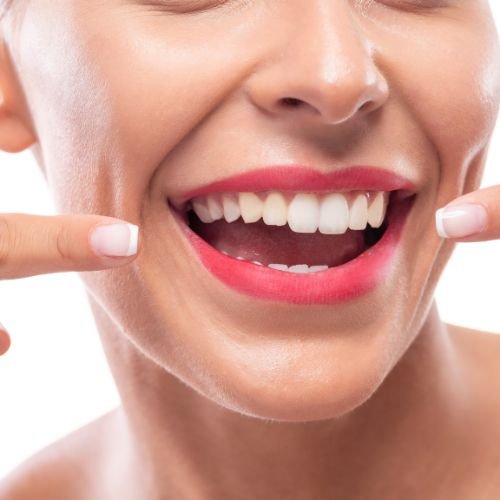Artistree Dental and Cosmetic Clinic
Home » Fixed Teeth
Fixed Teeth
Fixed Teeth
Understanding “Fixed Teeth”: A Guide to Restoring Smiles
The term “fixed teeth” isn’t a specific dental term but is often used to describe various options for restoring non-removable teeth. While it can encompass different approaches, understanding the individual procedures and their specific characteristics is crucial for making informed decisions about oral health.
- Dental Crowns: Restoring Damaged or Weakened Teeth
Description: A dental crown is a custom-made cap placed over a damaged, weakened, or misshapen tooth. It encases the entire visible portion of the tooth, restoring its shape, size, strength, and aesthetics.
Symptoms: Patients may experience various symptoms depending on the underlying condition:
- Pain or sensitivity: If the tooth is damaged or decayed, it might be sensitive to hot, cold, or sweet substances.
- Difficulty chewing: A cracked or fractured tooth can make chewing uncomfortable or painful.
- Discoloration: The tooth might appear discolored due to decay, trauma, or staining.
- Cosmetic concerns: The tooth’s appearance might be compromised due to cracks, chips, or excessive wear.
Causes: Dental crowns can address various situations:
- Severely decayed or fractured teeth: When a filling is insufficient to restore the tooth, a crown protects the remaining tooth structure and prevents further damage.
- Weak teeth: Crowns can strengthen teeth weakened by extensive fillings, root canals, or trauma.
- Discolored or misshapen teeth: Crowns can improve the aesthetics of teeth with significant discoloration, chips, or other cosmetic concerns.
- Supporting large fillings: In some cases, large fillings may require the additional support of a crown.
- Anchoring dental bridges: Crowns placed on healthy teeth adjacent to missing teeth can serve as anchors for a dental bridge.
Treatment: The process typically involves:
- Consultation and examination: The dentist assesses the tooth and discusses treatment options.
- Tooth preparation: The dentist removes a small amount of tooth enamel to accommodate the crown.
- Impression and temporary crown: An impression of the prepared tooth is taken, and a temporary crown is placed for protection until the permanent crown is ready.
- Permanent crown placement: The dentist permanently cements the custom-made crown onto the prepared tooth.
- Dental Bridges: Replacing Missing Teeth
Description: A dental bridge is a fixed dental restoration used to replace one or more missing teeth. It consists of artificial teeth (pontics) strategically suspended between dental crowns placed on the adjacent healthy teeth (abutment teeth). The bridge acts as a single unit, restoring both aesthetics and functionality.
Symptoms: Patients with missing teeth may experience various challenges:
- Difficulty chewing and speaking: Missing teeth can hinder proper chewing and speaking mechanics.
- Shifting of adjacent teeth: The gap left by missing teeth can cause surrounding teeth to shift out of position, affecting bite alignment and increasing the risk of further problems.
- Gap in the smile: Missing teeth can create gaps that affect aesthetics and confidence.
- Difficulty maintaining oral hygiene: Gaps can make it harder to clean teeth properly, potentially leading to gum disease.
Causes: Dental bridges are used to address situations where one or more teeth are missing due to:
- Tooth decay: Severe decay or neglected cavities can lead to tooth loss.
- Gum disease: Untreated gum disease can damage the supporting bone and tissue, causing teeth to loosen and fall out.
- Injury: Accidents or trauma can damage teeth beyond repair, necessitating extraction.
- Other factors: Congenital missing teeth or other factors can also necessitate tooth replacement.
Treatment: The process typically involves:
- Consultation and examination: The dentist assesses the missing teeth and surrounding teeth to determine suitability for a bridge.
- Teeth preparation: The dentist prepares the abutment teeth by removing a small amount of enamel to accommodate the crowns.
- Impressions and temporary restorations: Impressions are taken of the prepared teeth and surrounding area, and temporary crowns or bridges are placed for protection and aesthetics.
- Bridge fabrication: The dental lab creates the custom-made bridge based on the impressions.
- Bridge placement: The dentist permanently cements the bridge onto the prepared abutment teeth.
- Dental Implants: A Permanent Solution for Missing Teeth
Description: Dental implants are artificial tooth roots surgically placed in the jawbone. They act as anchors for dental prosthetics like crowns, bridges, or dentures. Implants offer a permanent and stable solution for replacing missing teeth and restoring functionality and aesthetics.
While not strictly classified as “fixed teeth” themselves, implants are crucial for supporting and anchoring dental prosthetics, providing a long-lasting solution for tooth loss.

Book an appointment
Procedure and Process Treatment

1. Consultations

2. Check Up

3. Treatments

